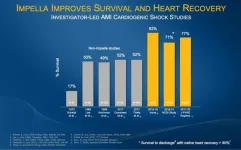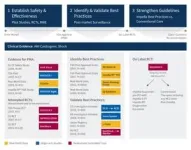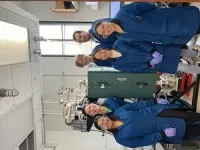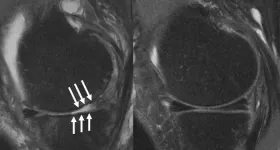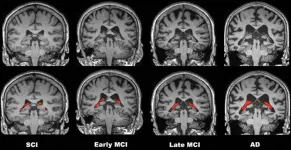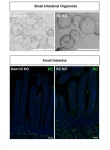(Press-News.org) DANVERS, Mass. – Nov. 27, 2023 – Abiomed, part of Johnson & Johnson MedTech[1], announces the first patient in the world has been enrolled in the landmark RECOVER IV randomized controlled trial (RCT). The on-label, two-arm trial will randomize 548 patients to assess whether Impella support prior to percutaneous coronary intervention (PCI) is superior to PCI without Impella in patients with acute myocardial infarction (AMI) cardiogenic shock.
Impella is the only mechanical circulatory support device for the treatment of AMI cardiogenic shock with premarket approval from the United States Food and Drug Administration. Multiples studies, including the Inova Study[2], the National Cardiogenic Shock Initiative (NCSI) Study[3] and the Japanese J-PVAD Study[4], have demonstrated significant improvement in AMI cardiogenic shock survival rates when Impella and best practices are implemented, including the use of Impella prior to PCI and identifying shock early. (See figure 1).
“Fifteen years of clinical studies have helped us establish best practices and shown that Impella increases survival and heart recovery in AMI cardiogenic shock patients,” said Chuck Simonton, MD, Abiomed’s chief medical officer. “The design of RECOVER IV, which incorporates those best practices, is intended to further validate the benefits of Impella utilization in AMI cardiogenic shock patients and provide evidence to achieve a Class 1 guideline recommendation.”
This first patient was enrolled at New Mexico Heart Institute by Mark Bieniarz, MD[5], an interventional cardiologist and the principal investigator for RECOVER IV at New Mexico Heart Institute. RECOVER IV is the first trial within the field of AMI cardiogenic shock to use the U.S. Food and Drug Administration’s (FDA) exception from informed consent (EFIC) protocol, an emergency research regulation. Since AMI cardiogenic shock patients are often too sick to provide consent, it has been difficult to study this patient population. Emergency research regulations require study investigators to consult and disclose information about the study with representatives from the community where the research will take place. EFIC allows for patients to be enrolled prior to obtaining traditional consent.
“We are thrilled to be the first site to enroll a patient into the historic RECOVER IV trial,” said Dr. Bieniarz. “The EFIC process provides us a pathway to successfully enroll patients and compare outcomes in patients who receive Impella support for acute myocardial infarction cardiogenic shock and those patients who do not receive Impella support for the same condition.”
The primary endpoint of RECOVER IV is all-cause mortality at 30 days. Secondary endpoints include major adverse cardiovascular and cerebrovascular events at 30 days, days alive out of the hospital at six months, recovery of left ventricular (LV) function, need for durable ventricular assist device or heart transplant, and health-related quality of life as measured by responses to the Kansas City Cardiomyopathy Questionnaire at one year. Abiomed’s goal in conducting the RECOVER IV RCT is to achieve AMI cardiogenic shock Class I guideline recommendations for Impella use in AMI cardiogenic shock. (See figure 2).
For more information about RECOVER IV, click here.
About Abiomed
Based in Danvers, Massachusetts, USA, Abiomed, part of Johnson & Johnson MedTech, is a leading provider of medical technology that provides circulatory support and oxygenation. Our products are designed to enable the heart to rest and recover by improving blood flow and/or provide sufficient oxygenation to those in respiratory failure. For additional information, please visit www.abiomed.com.
About Johnson & Johnson MedTech
At Johnson & Johnson MedTech, we unleash diverse healthcare expertise, purposeful technology, and a passion for people to transform the future of medical intervention and empower everyone to live their best life possible. For more than a century, we have driven breakthrough scientific innovation to address unmet needs and reimagine health. In surgery, orthopaedics, vision, and interventional solutions, we continue to help save lives and create a future where healthcare solutions are smarter, less invasive, and more personalized.
Cautions Concerning Forward-Looking Statements
This press release contains “forward-looking statements” as defined in the Private Securities Litigation Reform Act of 1995 regarding Abiomed technology. The reader is cautioned not to rely on these forward-looking statements. These statements are based on current expectations of future events. If underlying assumptions prove inaccurate or known or unknown risks or uncertainties materialize, actual results could vary materially from the expectations and projections of Abiomed, Inc. and/or Johnson & Johnson. Risks and uncertainties include, but are not limited to: uncertainty of commercial success; challenges to patents; competition, including technological advances, new products and patents attained by competitors; manufacturing difficulties and delays; product efficacy or safety concerns resulting in product recalls or regulatory action; changes to applicable laws and regulations, including global health care reforms; changes in behavior and spending patterns of purchasers of health care products and services; and trends toward health care cost containment. A further list and descriptions of these risks, uncertainties and other factors can be found in Johnson & Johnson’s Annual Report on Form 10-K for the fiscal year ended January 1, 2023, including in the sections captioned “Cautionary Note Regarding Forward-Looking Statements” and “Item 1A. Risk Factors,” and in Johnson & Johnson’s subsequent Quarterly Reports on Form 10-Q and other filings with the Securities and Exchange Commission. Copies of these filings are available online at www.sec.gov, www.jnj.com or on request from Johnson & Johnson. None of Abiomed, Inc. nor Johnson & Johnson undertakes to update any forward-looking statement as a result of new information or future events or developments.
[1]Abiomed, Inc. is part of Johnson & Johnson MedTech, which comprises the surgery, orthopedics, vision and interventional solutions businesses within Johnson & Johnson's MedTech segment.
[2] Tehrani, B., et al. (2019). J Am Coll Cardiol, 73(13), 1659-1669
[3] Basir, B., et al. (2021). SCAI Scientific Sessions
[4] Sawa, Y., (2020). Japanese Circulation Society, Kyoto
[5] Dr. Mark Bieniarz serves as PI for the RECOVER IV RCT at New Mexico Heart Institute. He is not compensated for his involvement with this research study or press release.
END
HOUSTON – (Nov. 27, 2023) – An international team of scientists led by Rice University’s Matteo Pasquali has won a $4.1 million grant to optimize carbon nanotube synthesis, a process that could help drive the green energy transition by providing more sustainable alternatives to materials dependent on heavy industry. The award is a joint effort by The Kavli Foundation, with a $1.9 million Kavli Exploration Award in Nanoscience for Sustainability, and Rice’s Carbon Hub, which contributed an additional $2.2 million.
“The energy transition is primarily a material transition,” Pasquali said. “Renewable energy ...
Hair products often contain ingredients that easily evaporate, so users may inhale some of these chemicals, potentially posing health repercussions. Now, researchers have studied emissions of these volatile organic compounds (VOCs), including siloxanes, which shine and smooth hair. The scientists report in ACS’ Environmental Science & Technology that using these hair care products can change indoor air composition quickly, and common heat styling techniques — straightening and curling — increase VOC levels even more.
Some ...
CHICAGO – Stronger quadriceps muscles, relative to the hamstrings, may lower the risk of total knee replacement, according to research being presented today at the annual meeting of the Radiological Society of North America (RSNA). Researchers said the findings could inform strength-training programs for people with advanced arthritis in the knee.
Advanced knee osteoarthritis is a major cause of pain and disability worldwide. In the U.S. alone, 14 million adults have symptomatic knee osteoarthritis, and more than half of those diagnosed are projected to eventually undergo total knee replacement surgery.
While stronger muscle groups are generally understood ...
CHICAGO – Black patients underwent medical imaging for cognitive impairment years later than white and Hispanic patients and were less frequently tested with MRI, according to research being presented this week at the annual meeting of the Radiological Society of North America (RSNA).
Previous studies have shown that Black patients are at increased risk of Alzheimer’s disease and other types of dementia. They are less likely to have a diagnosis and are diagnosed at a more advanced stage of disease compared to white patients.
Medical ...
About 1 in 10 prescription drugs — mainly brand-name and expensive drugs and those for rare diseases — has a manufacturer-sponsored patient support program, which usually includes financial, nursing and educational supports.
"In an era where policy-makers are grappling with escalating drug prices and budgetary impacts globally, the pharmaceutical industry promotes patient support programs as adding complementary value to a drug through supporting medication adherence and enhancing clinical outcomes, patient experience or quality of life," ...
Health Canada increased maximum residue limits for glyphosate in some crops, such as oats and beans, in 2021 despite concerns about the health impact of glyphosate-based herbicides (GBHs). The World Health Organization's (WHO) International Agency for Research on Cancer regards these pesticides as genotoxic, meaning they can damage DNA and are likely carcinogenic.
"Health Canada's PMRA considers pesticide sales and risk evaluation data in Canada to be confidential business information, and independent researchers cannot access these data, even through the Access to Information Act. Such ...
Stem cells can differentiate to replace dead and damaged cells. But how do stem cells decide which type of cell to become in a given situation? Using intestinal organoids, the group of Bon-Kyoung Koo at IMBA and the Institute for Basic Science identified a new gene, Daam1, that plays an essential role, switching on the development of secretory cells in the intestine. This finding, published on November 24 in Science Advances, opens new perspectives in cancer research.
Our bodies are, in some ways, like cars – to keep functioning, they need to be checked and repaired regularly. In the case of our bodies, ...
The Fens of eastern England, a low-lying, extremely flat landscape dominated by agricultural fields, was once a vast woodland filled with huge yew trees, according to new research.
Scientists from the University of Cambridge studied hundreds of tree trunks, dug up by Fenland farmers while ploughing their fields. The team found that most of the ancient wood came from yew trees that populated the area between four and five thousand years ago.
These trees, which are a nuisance when they jam farming equipment during ploughing, contain a treasure trove of perfectly preserved ...
A new study led by UCL researchers confirms that autistic people experience a reduced life expectancy, however the number of years of life lost may not be as high as previously claimed.
The research, published in The Lancet Regional Health – Europe, is the first to estimate the life expectancy and years of life lost by autistic people living in the UK.
The team used anonymised data from GP practices throughout the UK to study people who received an autism diagnosis between 1989 to 2019. They ...
Plants have no visual organs, so how do they know where light comes from? In an original study combining expertise in biology and engineering, the team led by Prof Christian Fankhauser at UNIL, in collaboration with colleagues at EPFL, has uncovered that a light-sensitive plant tissue uses the optical properties of the interface between air and water to generate a light gradient that is 'visible' to the plant. These results have been published in the journal Science.
The majority of living organisms (micro-organisms, plants and animals) have the ability to determine the origin of a light source, even in the absence of a sight organ comparable to the eye. This information is invaluable ...
